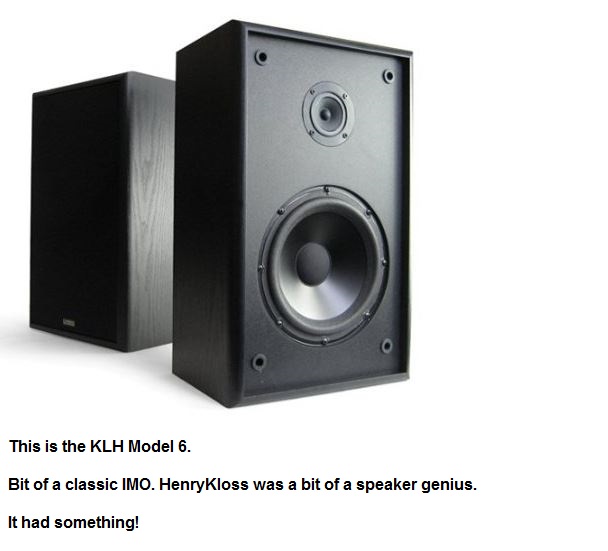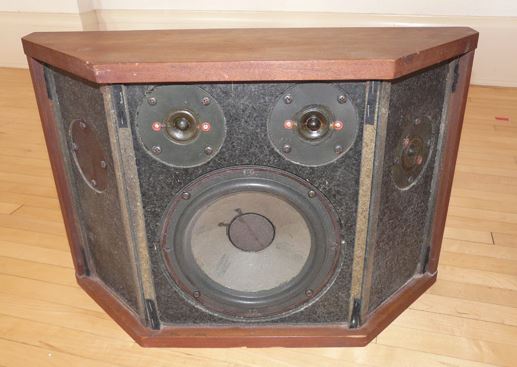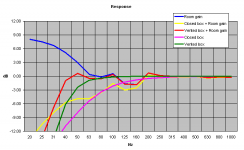You guys know I'm going for the Troll of the Year Award, right? 
Let me ask this question the nice way though.
I'm not doubting the physics of the baffle-step, or that it needs to be addressed int he cabinet and crossover combination. That all makes sense to me. However I wonder if in my own approach I'm doing things the "wrong" or "hard" way.
So far I've preferred to build the box, put the drivers in it, and measure what I have first, then build a crossover around that. Any BSC details will get taken care of for me, and I feel like I can jump over these problems entirely.
I have noticed that many DIY members however sweat the simulation of the BSC effect early as part of their design process.
So here is my real, not a troll, question:
What benefits to the design process in terms of time spent or flexibility of design (or something else) do you all feel I would have if I worried about BSC simulations?
Thanks,
Erik
Let me ask this question the nice way though.
I'm not doubting the physics of the baffle-step, or that it needs to be addressed int he cabinet and crossover combination. That all makes sense to me. However I wonder if in my own approach I'm doing things the "wrong" or "hard" way.
So far I've preferred to build the box, put the drivers in it, and measure what I have first, then build a crossover around that. Any BSC details will get taken care of for me, and I feel like I can jump over these problems entirely.
I have noticed that many DIY members however sweat the simulation of the BSC effect early as part of their design process.
So here is my real, not a troll, question:
What benefits to the design process in terms of time spent or flexibility of design (or something else) do you all feel I would have if I worried about BSC simulations?
Thanks,
Erik
IMO your method is the better one. Good measurements always beat sims. I think the BSC stuff is a vestige of the days when DIYers had poor access to good and easy-to-use measurement setups.
The devil is in the word "good." There's a great thread here somewhere with Jeff Bagby's "blender" paper and commentary by, among others, David Smith, Andrew Jones, and Dr Earl Geddes.
The devil is in the word "good." There's a great thread here somewhere with Jeff Bagby's "blender" paper and commentary by, among others, David Smith, Andrew Jones, and Dr Earl Geddes.
Well, one thing is that your bass alignment may be adapted based upon what your XO with baffle step looks like. If you can tweak the design before building the box, all the better.
But either way can get you there. Better still is active, or line-level passive, as then you don't have the typical RL circuit and associated losses.
But either way can get you there. Better still is active, or line-level passive, as then you don't have the typical RL circuit and associated losses.
Well, one thing is that your bass alignment may be adapted based upon what your XO with baffle step looks like. If you can tweak the design before building the box, all the better.
But either way can get you there. Better still is active, or line-level passive, as then you don't have the typical RL circuit and associated losses.
That's a really good point about the bass alignment. I just relied on online calculators.
You say "RL circuit and associated losses" as if they are a bad thing. I rely on those losses!
Best,
Erik
Right, 'best' is to design the LF system to be whatever efficiency greater required than the HF to tonally balance it, so may require horn loading or multiple LF drivers or at least HE Vs a lower efficiency HF.
GM
Horns scare me. I have visions of giant speakers in tiny little man hovels.
Erik
I don't believe it is necesary to take care of BSC.
BS only exists in the on-axis line, but it starts to desapear as soon as you leave the on-axis line, so.. if you apply BSC then yoy are "correcting" the on-axis radiation but you are also reinforcing quite dramatically your LF off-axis radiation. I prefer to let the roon take care of LF reinforcement and then correct a little by using the tone control or an equalizer...
BS only exists in the on-axis line, but it starts to desapear as soon as you leave the on-axis line, so.. if you apply BSC then yoy are "correcting" the on-axis radiation but you are also reinforcing quite dramatically your LF off-axis radiation. I prefer to let the roon take care of LF reinforcement and then correct a little by using the tone control or an equalizer...
GM
I don't believe it is necesary to take care of BSC.
No not necessary if toeing in and/or using EQ is an acceptable alternative, with the two combined being what I prefer.
GM
EriK, I presume you know enough about BS to know that it's mainly a concern with narrow baffle board width and the speaker will be placed well away from a wall.
It's a non-issue if the speaker will normally run against the wall. You know, 2 pi vs 4 pi and all?
Hi SD.
Yep, I understand how changing the surface area of the sphere or portion thereof that the drivers are radiating into affects efficiency and how it affects the rate at which the SPL decreases as a function of the distance from the origin. Well, at least in theory. Don't ask me for formulas.
My question was more about design patterns really. That is, whether others had a more efficient way of getting to "done" when it came to speaker design, and if doing BSC calculations was part of that.
Best,
Erik
In LASIP i can see the effect of the width of the baffle and i'm takin it into account.
I'm mainly working with small fullrange drivers and a proper design may minimize the cost for BSC. Depends on the project and the usage...
That's a new tool to me, or maybe I just am not getting the acronym. Post a link please?
Thanks!
Erik
Horns scare me. I have visions of giant speakers in tiny little man hovels.
Erik
They don't have to be big. I'm working on a bookshelf sized point-source horn:
http://www.diyaudio.com/forums/multi-way/285030-bookshelf-multi-way-point-source-horn.html
They don't have to be big. I'm working on a bookshelf sized point-source horn:
http://www.diyaudio.com/forums/multi-way/285030-bookshelf-multi-way-point-source-horn.html
XRK, I was trolling.
Erik
Did I ever show you a picture of a TROLL I took in Norway? We hunted these things all day, and then at dusk I bumped into one! Very proud of that picture, as it goes!XRK, I was trolling.Sorry.

Erik
On the subject of bafflestep, as people are saying, it only even theoretically applies on nearfield narrow monitors placed in the middle of the room.
Wallmounters don't need it at all and old designs never incorporated it. And I prefer that approach, because I hear the room gain and the power delivery (and BW3 is flatter on power than LR2 and LR4) more than the on-axis frequency response. So I always prefer smaller bass coils.


Attachments
In system7's attached picture we see that room gain helps only below 50-60Hz (typically). Baffle step (loss) with moderate sized speakers works much higher too and usually we get also floor reflection nulling around 200Hz.
Here is measured room response of a KEF LS50 positioned on a stand (red line). The speaker also has quite lean bass in typical British monitor fashion. Some may like this...
KEF LS50 Anniversary Model loudspeaker Measurements | Stereophile.com
-
The miniscule midbass driver of LS50 could not stand decent BSC, 4-6dB lower overall sensitivity would easily make the bass driver to blurb and burr, perhaps even break.
Here is measured room response of a KEF LS50 positioned on a stand (red line). The speaker also has quite lean bass in typical British monitor fashion. Some may like this...
KEF LS50 Anniversary Model loudspeaker Measurements | Stereophile.com
An externally hosted image should be here but it was not working when we last tested it.
-
The miniscule midbass driver of LS50 could not stand decent BSC, 4-6dB lower overall sensitivity would easily make the bass driver to blurb and burr, perhaps even break.
Last edited:
well, here is another experience that will cloud the water.
I ran a big system.
active 4 way, 4 amps, crossover points were 80hz (18db), 750hz (24db), and 5khz (24db).
4x18's ppsl subs, eminence 15" gamma, altec something on bowtie horn, motorola 1038a piezo.
The 15's had a sealed F3 of 80hz.
I ran 1 15" in box sitting on another 15" in its own box.
When I ran the lower 15" as a baffle step woofer (6db pole maybe 300-400hz), at low volumes you couldn't hear a difference. At medium volumes you could tell it made a little difference, but it made a huge difference at high volumes.
So..................
yea.
I ran a big system.
active 4 way, 4 amps, crossover points were 80hz (18db), 750hz (24db), and 5khz (24db).
4x18's ppsl subs, eminence 15" gamma, altec something on bowtie horn, motorola 1038a piezo.
The 15's had a sealed F3 of 80hz.
I ran 1 15" in box sitting on another 15" in its own box.
When I ran the lower 15" as a baffle step woofer (6db pole maybe 300-400hz), at low volumes you couldn't hear a difference. At medium volumes you could tell it made a little difference, but it made a huge difference at high volumes.
So..................
yea.
The problem with BSC is when it happens in frequencies where it's sort of too late for direct radiation, and too early for omni / room gain. I think it's better if BS happens either very high, or very low, but not in between. Otherwise speakers are more sensitive to placement and early reflections. When using larger baffles (40cm or more) things get much easier for 3 way - just a matter of adjusting woofer's slope - you kind of get most of the sound directly from the speaker and less from reflections. The FR is more constant, no matter where you place them
- Status
- This old topic is closed. If you want to reopen this topic, contact a moderator using the "Report Post" button.
- Home
- Loudspeakers
- Multi-Way
- Baffle Step - What's the point?

